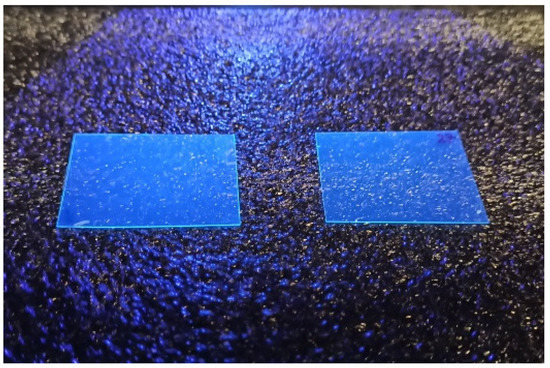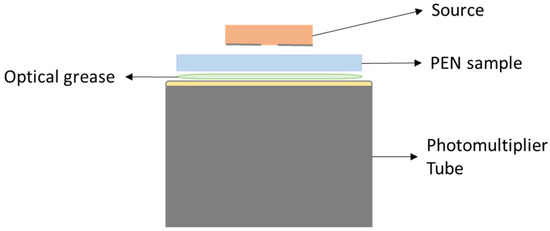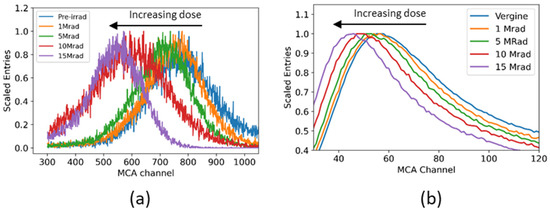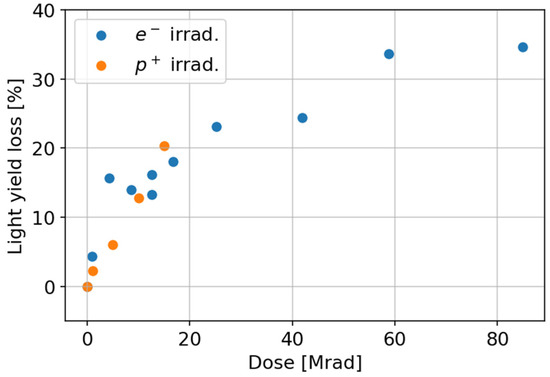Abstract
The radiation hardness of a Polyethylene Naphthalate (PEN) thin film scintillator has been characterized in terms of the light yield loss after irradiation with 11 MeV protons and 1 MeV electrons. The light yield distributions induced by excitation with radioactive sources have been measured on samples irradiated with different doses and the induced light loss has been computed. Results showed the good radiation hardness behaviors of PEN scintillators, with a light yield loss of ~15% at 10 Mrad and ~35% at the maximum delivered dose of 80 Mrad.
1. Introduction
Scintillators are transparent materials that emit light upon excitation by energetic charged particles. They are employed in several applications in order to detect energetic particles and measure their properties [1]. Recent works proved the possibility of using common low-cost plastic polymers such as Polyethylene Naphthalate (PEN) as a scintillator for radiation-sensing applications. PEN offers excellent scintillation properties such as high density (1.33 g/cm3), a peak emission wavelength at ~425 nm, and a light yield of roughly 104 photons/MeV [2,3,4].
Because of these good properties, along with its ease of manufacture and low cost, PEN has drawn the attention of the scientific community. Its field of employment ranges from dosimetry purposes in irradiation facilities or nuclear medicine [5] to particle energy measurement in High Energy Physics (HEP) colliders and underground experiments [6,7]. However, many of these applications require the instrumentation to operate in very high-radiation environments, raising the issue of the detector’s radiation hardness to a high level of priority [8]. Several works have already probed the good characteristics of PEN irradiated up to 20 Mrad [9,10,11].
In this work, we investigate the radiation hardness of a PEN thin-film scintillator. Several samples have been irradiated in air with a 11 MeV proton beam and a 1 MeV electron beam at the maximum doses of 15 Mrad and 80 Mrad, respectively. The radiation-induced damage has been measured in terms of light yield loss as a function of the dose. This investigation revealed good radiation hardness behaviors of the PEN, with a light yield loss of ~15% at 10 Mrad and ~35% at the maximum delivered dose of 80 Mrad.
2. Materials and Methods
Several tiles of 30 × 40 mm2 were obtained from a Teonex® PEN film of 100 µm thickness, as shown in Figure 1.

Figure 1.
Two 30 × 40 mm2 tiles of a PEN thin-film scintillator illuminated with UV light.
The samples were irradiated in air at controlled room temperature with two particle species (protons and electrons) at several doses. The proton irradiation was performed at the Tandem accelerator of the INFN Laboratori Nazionali del Sud. The actual energy of the beam on the sample surface was 11 MeV, and the maximum achieved dose was 15 Mrad. The irradiation with 1 MeV electrons was performed at the ILU-6 accelerator at the Centre for Radiation Research and Technology of Institute of Nuclear Chemistry and Technology (INCT) in Warsaw (Poland). In this case, given the high particle flux available, doses up to 80 Mrad were achieved.
The radiation-induced damage was measured in terms of the scintillator light yield loss. The PEN scintillator light yield was characterized upon excitation with radioisotope sources by coupling the samples to a Hamamatsu R5900 Photo-Multiplier Tube (PMT) with a square and flat light input surface. A schematic representation of the experimental setup is shown in Figure 2.

Figure 2.
Schematic representation of the experimental setup for the PEN thin-film scintillator’s light yield measurement.
The samples were optically coupled to the PMT by means of a thin layer of optical grease. The radioactive source was positioned on the other face of the scintillator on top of a thin collimator. Two sources were used: 241Am, which decays mainly via alpha-decay with the main emission of a 5.486 MeV alpha particle, and 137Cs, which decays via beta-decay by emitting electrons with a maximum energy of 0.51 MeV.
The output signal from the PMT was sent to an amplifier whose output was read and acquired via a spectroscopy Multichannel Analyzer (MCA) interfacing with a PC.
3. Results
Prior to the irradiation campaign, all samples were characterized in terms of light yield, where they exhibited good consistency with each other.
Fluctuations remained within 2–3%, mainly due to the non-perfect reproducibility of the optical coupling with the PMT.
After the irradiation, the samples were kept in a dark environment at a controlled temperature of 25 °C for 60 days prior to characterizing them. According to [9], PEN scintillators demonstrate a partial damage recovery mechanism which reaches a plateau, with a characteristic time of about 10 days. Figure 3 shows, as an example, the light yield spectra measured on proton-irradiated samples with the Cs and Am sources. As the intent of this paper is to study the relative degradation induced by radiation, an absolute multichannel analyzer calibration was not performed. The effect of irradiation is clearly observable as a reduction of the pulse height, here measured in terms of channels of the MCA.

Figure 3.
Light yield spectra of proton irradiated thin-film PEN scintillators excited by (a) alpha particles from a 241Am source and (b) electrons from a 137Cs source.
The percentage light loss after irradiation was then computed as a function of the delivered dose. Similar trends were observed in measurements with Am and Cs. In Figure 4, we report the percentage light yield loss measured with the Cs source in samples irradiated with protons and electrons.

Figure 4.
Percentage light yield loss after electron and proton irradiations as a function of the delivered dose measured upon excitation with a 137Cs source.
This investigation revealed a reduction of the light yield emission, with similar trends for both irradiation beams. A slowing down of the damage with increasing dose is clearly observable, suggesting that most of the chemical reactions that lead to the deterioration of performances occur early in the exposure.
4. Conclusions
Polyethylene Naphthalate (PEN) thin-film scintillators have been characterized in terms of the light yield loss after irradiation with 11 MeV protons and 1 MeV electrons. A reduction of the light yield emission, with similar trends for both irradiation beams, has been observed.
This investigation revealed the good radiation hardness behaviors of PEN scintillators. A light yield loss of ~15% at 10 Mrad and ~35% at the maximum delivered dose of 80 Mrad was observed.
The results described in this work enrich the literature on radiation hardness studies on plastic scintillators, providing useful information for the introduction of PEN scintillators in nuclear, space and HEP applications.
Author Contributions
Conceptualization and methodology, M.C. and F.D.C.; measurements and data analysis, M.C. and F.D.C.; writing—original draft preparation, M.C.; writing—review and editing, A.A., M.C., F.D.C. and E.S. All authors have read and agreed to the published version of the manuscript.
Funding
This research has been partially funded by the CSN V of INFN, in the framework of the FIRE experiment.
Institutional Review Board Statement
Not applicable.
Informed Consent Statement
Not applicable.
Data Availability Statement
The data presented in this study are available on request from the corresponding author.
Conflicts of Interest
The authors declare no conflict of interest.
References
- Leo, W.R. Techniques for Nuclear and Particle Physics Experiments: A How-to Approach, 2nd ed.; Springer: Berlin/Heidelberg, Germany, 1992. [Google Scholar]
- Nakamura, H.; Shirakawa, Y.; Takahashi, S.; Shimizu, H. Evidence of deep-blue photon emission at high efficiency by common plastic. Europhys. Lett. 2011, 95, 22001. [Google Scholar] [CrossRef]
- Nakamura, H.; Shirakawa, Y.; Kitamura, H.; Yamada, T.; Shidara, Z.; Yokozuka, T.; Nguyen, P.; Takahashi, T.; Takahashi, S. Blended polyethylene terephthalate and polyethylene naphthalate polymers for scintillation base substrates. Radiat. Meas. 2013, 59, 172–175. [Google Scholar] [CrossRef]
- Wetzel, J.; Tiraş, E.; Bilki, B.; Bostan, N.; Köseyan, O.K. Scintillation timing characteristics of common plastics for radiation detection excited with 120 GeV protons. Turk. J. Phys. 2020, 44, 437–441. [Google Scholar] [CrossRef]
- Flühs, D. Polyethylene Naphthalate Scintillator: A Novel Detector for the Dosimetry of Radioactive Ophthalmic Applicators. Ocul. Oncol. Pathol. 2015, 1, 5–12. [Google Scholar] [CrossRef] [PubMed]
- Kuźniak, M.; Broerman, B.; Pollmann, T.; Araujo, G.R. Polyethylene naphthalate film as a wavelength shifter in liquid argon detectors. Eur. Phys. J. Ocul. Oncol. Pathol. 2018, C79, 1–6. [Google Scholar] [CrossRef]
- Efremenko, Y.; Fajt, L.; Febbraro, M.; Fischer, F.; Hayward, C.; Hodák, R.; Kraetzschmar, T.; Majorovits, B.; Muenstermann, D.; Öz, E.; et al. Use of poly(ethylene naphthalate) as a self-vetoing structural material. JINST 2019, 14, 7006. [Google Scholar] [CrossRef]
- Kharzheev, Y.N. Radiation Hardness of Scintillation Detectors Based on Organic Plastic Scintillators and Optical Fibers. Phys. Part. Nuclei 2019, 50, 42–76. [Google Scholar] [CrossRef]
- Markley, F.; Woods, D.; Pla-Dalmau, A.; Foster, G.; Blackburn, R. Development of Radiation Hard Scintillators. Radiat. Phys. Chem. 1993, 41, 135–152. [Google Scholar] [CrossRef][Green Version]
- Wetzel, J.; Tiras, E.M.; Bilki, B.; Onel, Y.; Winn, D. Radiation damage and recovery properties of common plastics PEN (Polyethylene Naphthalate) and PET (Polyethylene Terephthalate) using a 137Cs gamma ray source up to 1 MRad and 10 MRad. JINST 2016, 11, 08023. [Google Scholar] [CrossRef][Green Version]
- Wetzel, J.; Tiras, E.M.; Bilki, B.; Onel, Y.; Winn, D. Using LEDs to stimulate the recovery of radiation damage to plastic scintillators, Nucl. Inst. Meth. B 2017, 395, 13–16. [Google Scholar] [CrossRef]
Publisher’s Note: MDPI stays neutral with regard to jurisdictional claims in published maps and institutional affiliations. |
© 2021 by the authors. Licensee MDPI, Basel, Switzerland. This article is an open access article distributed under the terms and conditions of the Creative Commons Attribution (CC BY) license (https://creativecommons.org/licenses/by/4.0/).